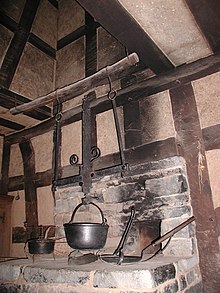Hearth
**Archaeological Features:**
– A hearth is a firepit or fireplace feature in archaeology
– Hearths are common in prehistoric campsites
– They were used for cooking, heating, and processing resources
– Lined hearths have fire-cracked rock and organic waste
– Radiocarbon dating can determine the last use of a hearth
**Hearth Tax:**
– Byzantine Empire had a hearth tax called kapnikon
– England introduced a hearth tax in 1662
– Exemptions were granted based on income and property value
– The tax was abolished by William III in 1689
– Hearth tax records indicate house sizes and wealth distribution
**Religion and Folklore:**
– Hestia is the Greek goddess of the hearth
– Vesta has a similar role in Roman mythology
– Zoroastrian traditions in Persia required a hearth for sacrifices
– Albanian folk beliefs connect the hearth to past, present, and future
– “Hearth” is a term for a family unit in the Heathen religion
**Related Links:**
– Wikimedia Commons has media related to Hearths
– Etymology of the root *ker- can be found on etymonline
– John F. Haldon’s book on Byzantium in the Seventh Century
– Jeremy Gibson’s work on the Hearth Tax and Stuart Tax Lists
– Mary Boyce’s book on the history of Zoroastrianism
**Illustrations and Features:**
– Late medieval tile hearth and associated floor
– Japanese traditional hearth (Irori)
– William Blake’s cauldron over a fire illustration
– Dutch style kitchen hearth in Hofwijck mansion
– Illustration of the hearth in John Howard Payne’s house in an 1889 cookbook
A hearth (/hɑːrθ/) is the place in a home where a fire is or was traditionally kept for home heating and for cooking, usually constituted by at least a horizontal hearthstone and often enclosed to varying degrees by any combination of reredos (a low, partial wall behind a hearth), fireplace, oven, smoke hood, or chimney. Hearths are usually composed of masonry such as brick or stone. For centuries, the hearth was such an integral part of a home, usually its central and most important feature, that the concept has been generalized to refer to a homeplace or household, as in the terms "hearth and home" and "keep the home fires burning". In the modern era, since the advent of central heating, hearths are usually less central to most people's daily life because the heating of the home is instead done by a furnace or a heating stove, and cooking is instead done with a kitchen stove/range (combination cooktop and oven) alongside other home appliances; thus many homes built in the 20th and 21st centuries do not have hearths. Nonetheless, many homes still have hearths, which still help serve the purposes of warmth, cooking, and comfort.

Before the industrial era, a common design was to place a hearth in the middle of the room as an open hearth, with the smoke rising through the room to a smoke hole in the roof. In later designs which usually had a more solid and continuous roof, the hearth was instead placed to the side of the room and provided with a chimney.
In fireplace design, the hearth is the part of the fireplace where the fire burns, usually consisting of fire brick masonry at floor level or higher, underneath the fireplace mantel.
